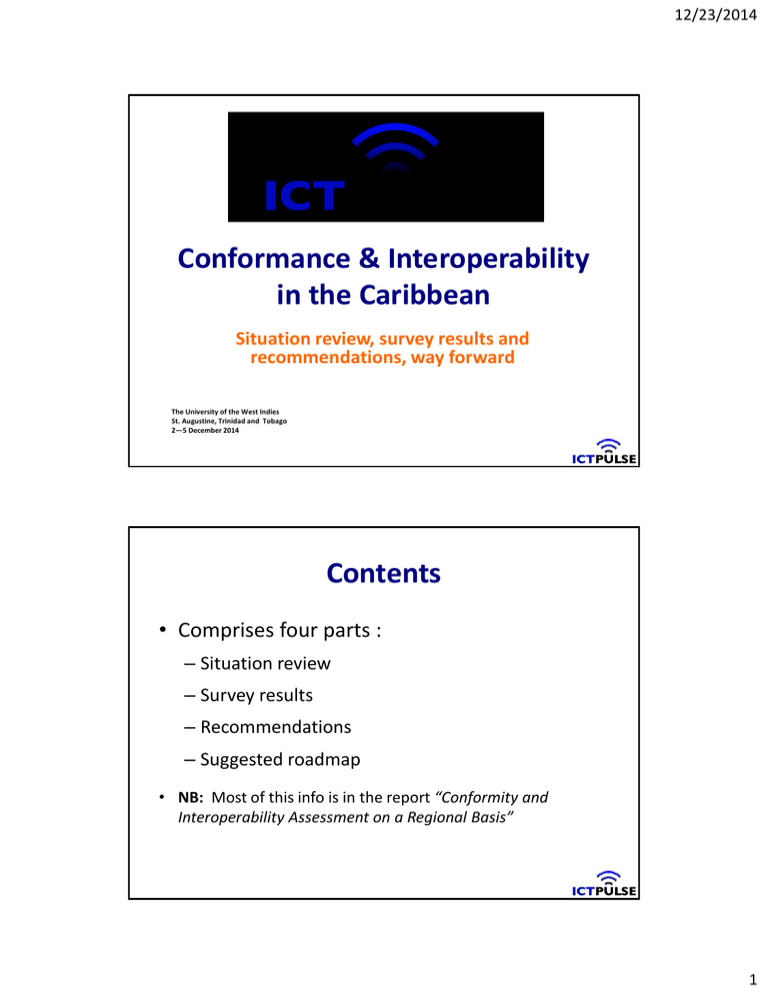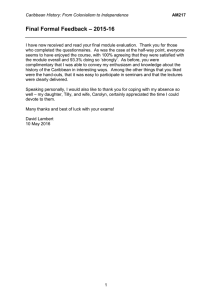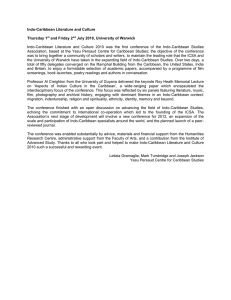Conformance & Interoperability in the Caribbean Contents • Comprises four parts :
advertisement

12/23/2014 Conformance & Interoperability in the Caribbean Situation review, survey results and recommendations, way forward The University of the West Indies St. Augustine, Trinidad and Tobago 2—5 December 2014 Contents • Comprises four parts : – Situation review – Survey results – Recommendations – Suggested roadmap • NB: Most of this info is in the report “Conformity and Interoperability Assessment on a Regional Basis” 1 12/23/2014 SITUATION REVIEW Area of focus: the Caribbean Source: University of Texas 2 12/23/2014 Caribbean is a diverse set of islands and territories • Though the countries are in the same geographical region, they differ considerably, e.g. – Population: from about 5K in Montserrat, to over 10.6M in Dom Rep – Land Area: from 91 sq. km for Anguilla, to 214,969 sq. km for Guyana – GDP: from USD 175M in Anguilla, to USD 62.79B in Dom Rep Challenge of being SIDS countries • Except Haiti, all other Caribbean countries are categorised as Upper Middle Income (UMI) and Higher Income (HI) by the World Bank • However, except Bermuda, all of the countries in assignment are classified as Small Island Developing States (SIDS) • Vulnerabilities include: – relatively small but growing populations – susceptibility to natural disasters, e.g. hurricanes and earthquakes – excessive dependence on international trade and on markets in the developed world – poor infrastructure – relatively high poverty and social inequities – fragile environments, and greater susceptibility to the effects of climate change 3 12/23/2014 Most countries have fully liberalised telecoms/ICT sectors • POTS has experienced a steady decline since 2000 – Approx. 31 subscriptions per 100 pop (2013) • Mobile/cellular service experienced considerable take-up since 2000 – Approx. 115 subscriptions per 100 pop (2013) • Fixed broadband subscriptions and Internet use are increasing – Approx. 17 subscriptions per 100 pop (2013) – Approx. 55 Internet users per 100 pop (2013) Regional organisations involved in standards development • Caribbean Telecommunications Union (CTU) – foster coordination of technical standards within region • CARICOM Regional Organisation for Standards and Quality (CROSQ) – develop and harmonise standards, metrology, technical regulations, MRAs for CARICOM countries • Eastern Caribbean Telecommunications Authority (ECTEL) – harmonise, recommend, coordinate select technical stds for its Member States 4 12/23/2014 Many countries focus on Type Approval • Type Approval is a special kind of certification granted in country – Type approval processes and requirements differ across the region • In the region, 3rd party declaration based on markings by recognised agencies generally accepted • Specific classes of telecoms/ICT equipment may need to be authorised, e.g. by the regulator, for entry into some countries • Most countries do not have formal MRAs in place Limited training currently available in the Caribbean • Currently no known training programme in the region to develop C&I and MRA expertise • CTU is a Caribbean Centre of Excellence (CCoE) and may be able to arrange programmes; none currently in C&I • Most countries take advantage of online resources and training that might be available from PURC, UWI and USTTI to name a few 5 12/23/2014 Summary • Many Caribbean countries view ICT/telecoms as a critical driver of development – Traditionally, the focus has been on access – infrastructure and take-up • Regional telecoms bodies exist (CTU, ECTEL), also a regional standards body, CROSQ), but to date no major effort, re C&I for telecoms/ICT • C&I frameworks and structures in the Caribbean appear to be limited • Type approval and acceptance of 3rd party certification tend to be the focus • Training and other capacity building structures on C&I are limited (virtually non-existent) in the region. SURVEY RESULTS 6 12/23/2014 16 Submissions from 14 countries Most countries have a regulatory framework re technical requirements 7 12/23/2014 Most countries accept some form of certification for conformity Most countries have stds framework, but no stds development orgs 8 12/23/2014 >60% responses stated local body for Conformity Assessment Development >90% of respondents stated countries have import control laws & regs • Most countries have inspection at port of entry, usually through Customs – Some also engage in spot checks and post market surveillance • Re post market surveillance, they tend to occur on an ad hoc basis • When counterfeit products are found, a few countries will confiscate them; others do not have systems in place to address this 9 12/23/2014 Accreditation, labs, certification still underdeveloped • Over 85% of respondents stated there was no accreditation body in their country • No labs in the region do 1st party testing – A few might do 2nd and 3rd party testing • In a handful of countries, the local stds bureau reportedly act as certification bodies – In one country, regulator listed as the certifying body • Most countries trust marks from entities such as – UL, IEC, CSA, FCC, EU Summary • Most countries have a regulatory framework for technical requirements for the importation ICT products and services • There are a broad range of Conformity Assessment Schemes in effect in the region, some of which are ISO/CASCO compliant • There are differing positions on matters related to delegation of authority and MRAs • Most countries have a national stds system, and are prepared to adopt international stds • Most countries have metrology laws and a national institute of metrology • Most countries do not have a local accreditation body, nor did they have accredited testing laboratories • The local regulator is responsible for certification in some countries • Trusted Marks of Conformity include: EU, FCC, IEC, UL and CE 10 12/23/2014 Any Questions? Michele Marius ICT Pulse Consulting Limited Blog: ict-pulse.com FB: facebook.com/ICTPulse Twitter: @ictpulse 11

